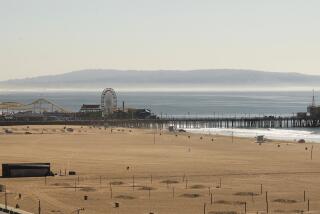NEWPORT BEACH : Encroachment Plan Readied for Review
City officials will present a tentative agreement to the City Council next week on a plan to regulate the controversial beachfront encroachments.
City Manager Robert L. Wynn said the agreement, which calls for the city to pave street extensions and improve beach access for handicapped persons, specifies that 85% of fees collected for encroachment permits would be used to make improvements to the extensions of 33 streets over 10 years. The remaining 15% would be used for administrative costs.
When all the streets are improved, the money would go into a fund for further beach improvements. In addition, the agreement eliminates an earlier proposal for an extended sidewalk in west Newport, which the state Coastal Commission had originally suggested as a fair trade to allow encroachments.
The Coastal Commission, which regulates use and development of the state’s coastline, in January rejected the city’s encroachment policy because it did not offer specific plans allowing beachfront homeowners to extend structures such as decks, patios and spas onto the public right of way.
The policy, adopted in 1990 after a year of public debate, allowed some oceanfront property owners to extend private structures up to 15 feet on to public-access areas, while residents in other areas of the city could only encroach 7 1/2 feet.
The encroachments would have been permitted in exchange for access improvements by the city, financed by annual encroachment-permit fees ranging from $300 to $600, depending on how far private structures extended onto public property.
If the council approves the tentative agreement, it will pave the way for city officials to draft a new encroachment policy and deliver it to the 12-member Coastal Commission for review, Wynn said. If passed by the commission, the new plan would be returned to the City Council for public hearings.
Chuck Damm, South Coast district director of the state Coastal Commission, said he expects the commission to vote on the agreement at its May or July meeting, when the board will gather in San Diego and Huntington Beach, respectively.
Damm said the plan has a “reasonably good chance” of getting commission approval.
“The city is proposing some significant mitigation for the allowing of the encroachments onto that easement,” he said, noting that the city has agreed to pave the ends of streets from Sea Shore Drive to the beach, and from 36th Street to the Santa Ana River.
In addition, the city would improve access to the beach for handicapped persons by adding more parking spaces or limiting some existing spaces to handicap parking only.
“What they are suggesting to us now is quite a bit different from what they were proposing a few months ago,” Damm said. “As long as they have that wide sandy beach, this is a fair trade-off.”
More to Read
Sign up for Essential California
The most important California stories and recommendations in your inbox every morning.
You may occasionally receive promotional content from the Los Angeles Times.










